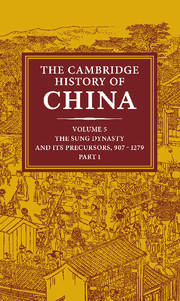Book contents
- Frontmatter
- Introduction: the Sung Dynasty and Its Precursors, 907–1279
- 1 The Five Dynasties
- 2 The Southern Kingdoms between the T’ang and the Sung, 907–979
- 3 Founding and Consolidation of the Sung Dynasty under T’ai-tsu (960–976), T’ai-tsung (976–997), and Chen-tsung (997–1022)
- 4 The Reigns of Jen-tsung (1022–1063) and Ying-tsung (1063–1067)
- 5 Shen-tsung’s Reign and the New Policies of Wang An-shih, 1067–1085
- 6 Che-tsung’s Reign (1085–1100) and the Age of Faction
- 7 The Reigns of Hui-tsung (1100–1126) and Ch’in-tsung (1126–1127) and the Fall of the Northern Sung
- 8 The Move to the South and the Reign of Kao-tsung (1127–1162)
- 9 The Reign of Hsiao-tsung (1162–1189)
- 10 The Reigns of Kuang-tsung (1189–1194) and Ning-tsung (1194–1224)
- 11 The Reign of Li-tsung (1224–1264)
- 12 The Reign of Tu-tsung (1264–1274) and His Successors to 1279
- Bibliography
- Glossary–Index
- References
1 - The Five Dynasties
Published online by Cambridge University Press: 28 March 2010
- Frontmatter
- Introduction: the Sung Dynasty and Its Precursors, 907–1279
- 1 The Five Dynasties
- 2 The Southern Kingdoms between the T’ang and the Sung, 907–979
- 3 Founding and Consolidation of the Sung Dynasty under T’ai-tsu (960–976), T’ai-tsung (976–997), and Chen-tsung (997–1022)
- 4 The Reigns of Jen-tsung (1022–1063) and Ying-tsung (1063–1067)
- 5 Shen-tsung’s Reign and the New Policies of Wang An-shih, 1067–1085
- 6 Che-tsung’s Reign (1085–1100) and the Age of Faction
- 7 The Reigns of Hui-tsung (1100–1126) and Ch’in-tsung (1126–1127) and the Fall of the Northern Sung
- 8 The Move to the South and the Reign of Kao-tsung (1127–1162)
- 9 The Reign of Hsiao-tsung (1162–1189)
- 10 The Reigns of Kuang-tsung (1189–1194) and Ning-tsung (1194–1224)
- 11 The Reign of Li-tsung (1224–1264)
- 12 The Reign of Tu-tsung (1264–1274) and His Successors to 1279
- Bibliography
- Glossary–Index
- References
Summary
introduction
By the early tenth century, political control in the T’ang empire had been divided among regional governors, commanders, and warlords for some hundred and fifty years. This division of political power resulted chiefly from the effects of the momentous rebellions (755–63) of An Lu-shan and his followers, in which the capitals at Lo-yang and Ch’ang-an were seized, and the T’ang emperor driven into exile. By 907 the remnants of T’ang control of the central Yellow River valley had been extinguished. Over the next fifty-three years, control of this region, from Ch’ang-an to K’ai-feng, would be seized and relinquished by several successive claimants, each trying, and for the most part failing, to construct a sustainable base of power – the Later Liang, the Later T’ang, the Later Chin, the Later Han, and the Later Chou. During this time, known as the Five Dynasties period, regions outside the Yellow River valley that were once part of the T’ang empire were under administrative control of different sets of claimants also trying to legitimize and strengthen their rule.
In this period of social instability and near constant warfare, allegiances among regional commanders drove political events forward. In this chapter I examine the campaigns and allegiances, internal and external, that framed political events in the central Yellow River valley – the great center of power in the T’ang dynasty – and discuss how the development of allegiance strategies increased a ruler’s ability to administer troops and resources, culminating fifty years later in a military force strong enough to conquer much of the southern territory once held by the T’ang.
- Type
- Chapter
- Information
- The Cambridge History of China , pp. 38 - 132Publisher: Cambridge University PressPrint publication year: 2009
References
- 4
- Cited by

